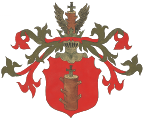“A tree without roots is just a piece of wood.”
― Marco Pierre White
Wouldn’t you love to meet your great-grandparents? Or at least, as an invisible man hover above their farm and watch them for a day or so?
I would.
Their farm in still there.
But the only thing left after my ancestors are the tombstones and the documents stashed in church vaults. So I dove into, much popular now, genealogy.
Here is a plaque from my parents’ grave. The grave is located in Camarillo, in California. I know, I put it there.
This is a gravestone from my grandparents’ burial place. It is in Sonsk, some fifty miles north of Warsaw. It is located in the graveyard at a beautiful church, where all the weddings, funerals and baptisms of my family for centuries took place. The church reminded of all the magnificent gothic sanctuaries I had seen in the South and West of Europe.
The cross, which you can see high on the tower, was put there by my grandfather, Leon, as my father, Stanisław, proudly related to me. So, with the help of the internet, I invaded the riches of the archives of their church. The history of the parish is as long as it is turbulent. This Catholic parish was established in the eleventh century there, which is remarkable since the country was formally established in 966 AD. On the 14th of April, our prince, Mieszko, was crowned, and we achieved a status of an independent nation. For the ceremonies, the bishop came from Rome. This was not only a religious milestone, but also a political move, not to become dependent on Germany or Russia.
There were countless wars ravaging our farm, with troops marching through the land in all the directions. The church was destroyed in 1598 by a hurricane, and in addition, many times the building was vandalized during the wars. The invaders came from everywhere: the Germans, the Russians, the Swedes and even our friends from Lithuania took a part in the fighting. The last building was erected in 1904-1905, and it was then when my grandfather carried the cross to the top of a tall tower. I could imagine twenty-some years Leon, climbing the ladders, carrying the huge cross probably strapped to his back, while the rest of the congregation watched from below. I could see his mother, Wiktoria, holding the rosary, and praying for his safety. I could also see his father, Julian, yelling the words of encouragement, and announcing to everyone who did and didn’t want to hear, “That’s my boy!”
My grandfather, Leon, was married to my grandmother, Ludwika, in 1910, five years after the cross was hoisted. And in 1912, my father was born, as the oldest of their five children.
But what about Leon’s father? I had to dig deeper.
I was lucky enough to access the church archives and that’s what I found.
Each calendar year has a book, which is divided into three parts: births, weddings, and funerals. I found the archives for the nineteenth-century documents. All written in a neat cursive. The problem came when I realized that in the first two-thirds of the nineteenth century, they were written in Polish and the in the last part in Russian. Why? Well, there was an uprising in Poland in 1863. The Russian had brutally put it down, and as a punishment, the Russian language was imposed as an official language in then occupied Poland.
I knew grandfather Leon was born in 1872. And I found the entry of his baptism.
Now, I can read typed Russian, but even the neatest cursive presents itself with a challenge.
So, here is the translation.
It took place in the Village of Sonsk on May 4/16, 1879 at 7 am. The one who came in person was Julian Niesłuchowski, a landlord, dwelling in Niesluchy, 45 years old; in the presence of Tomasz Ropelewski, 53 years old, as well as Piotr Niesłuchowski, 50 years old, small estate owners living in Niesluchy, – who presented a male baby, saying that he was born in Niesluchy on April 30/May 12 this current year at 6 am by his lawful wife Wiktoria, née Pajewski, 39 years old. At the holy baptizing conducted on this date by the priest Wincenty Podbielski, the baby was given the name Leon, and his godparents were Tomasz and his wife Józefa Bieńkowski living in Burkat. This certificate was read by me to the declaring person and the witnesses, it was signed by the declaring person; the witnesses were illiterate. The Roman Catholic priest Wincenty Podbielski, rector of Sonsk parish, a keeper of the acts of the civil status. (Signed) Julian Niesluchowski, father (On the left margin) On 6/19 of
On 6/19 of November 1910, in the Roman Catholic Church of Sonsk parish, Leon Niesluchowski got married to Ludwika Zbikowska.
This statement is signed by Julian Niesłuchowski, the father who brought the newborn son, Leon. So at least I know he knew how to write. I know that he was forty-five-years-old and his wife’s name was Wiktoria née Pajewska, thirty-nine. Now I just have to go back and find the book from 1834 when presumably my great-grandfather was born.
I also found out, that my grandfather, Leon, married Ludwika Żbikowska on 6/19 of November 1910. My grandfather’s Leon baptism was on May 4/16 of 1879. Why two dates? Well, I’m glad you asked. When the Russians put down the insurgency in 1863, they also imposed a ruthless russification of the country. Besides making the Russian language mandatory, they also imposed Russian, orthodox Gregorian calendar. They still celebrate Christmas on the January 7.
Oh, and I also found our Coat of Arms.


